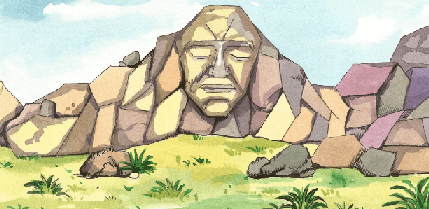The Great Stone Face Summary Class 8 English Honeydew
The Great Stone Face was the work of nature. It was formed on the side of a mountain by some rocks. Seen from a distance they looked like a human face and alive. Going near, the face turned into a heap of rocks. The people believed that the valley owed much of its fertility to that face.
One day a mother and her little child, Ernest sat at the door of their cottage. He wished that the Great Stone Face could speak. The mother hoped to see a man some time with a similar face. She told a curious story, she herself had heard in her childhood. A great man bearing that stone face would be born some day. That was a prophecy.
Ernest could never forget that story. He was very helpful to his mother. He grew up to be a gentle, quiet young man. The Stone Face became his teacher. The child used to watch it for hours.

Once a rumour spread that the great man, who was to bear a resemblance to the Great stone face, had appeared at last. Many years ago, a young man had left the valley and settled at a distant seaport. He became very rich. Then he decided to return to his native place. He was Mr. Gathergold. People welcomed him as the great man because he resembled the great stone face. But Ernest didn’t agree with these people.
Years went on. Ernest grew to be a young man. He drew little attention. He had nothing remarkable. But he was hardworking and kind. He still loved to gaze upon the great stone face. He wondered why the stone faced man was taking so long in coming to that valley.
Mr. Gathergold died as a poor man and was buried. People then agreed that there was no likeness between the ruined merchant and the majestic face upon the mountain.
It so happened that another son of the valley returned to his native valley. He had become a famous commander. The people turned to him blindly and accepted him as the Great Stone Face. But Ernest could not see any similarity between them.
Notes For the Teacher
- A classic piece of American fiction juxtaposing mellowness of humanism with magnificence of art. Ernest, an unschooled dweller of the valley, has close affinity with the ‘Stone Face’ atop the hills beyond. Who resembles the splendid Stone Face — not someone for all his wealth, not someone else for all his heroic deeds, and not someone else yet again for his poetry and sublime ideas. It is none other than Ernest who personifies a rare blend of basic simplicity, practical wisdom and deep love for humanity.
- The original story has been heavily abridged. Simplification has been avoided in the interest of authenticity. You may like to read the unabridged text for pleasure and edification.
- Design three or four while-reading comprehension questions for each section of the text (parts I and II)
- The writing activity (Part-II : IV) is for further practice in language analysis. Rearranging phrases to construct sentences and then rearranging sentences to construct a paragraph will provide many opportunities for thinking about cohesion and coherence.
- Activities 1 and 2 under working with language (Part I) on adding -ness and -ity for forming nouns and adding -ly to adjectives for forming adverbs should be completed in three or four sessions. One period may be devoted to each item including resolving intermittent queries and offering explanations and the writing work involved.
FAQs on The Great Stone Face Summary Class 8 English Honeydew
| 1. What is the story "The Great Stone Face" about? |  |
| 2. Who is Ernest in "The Great Stone Face"? |  |
| 3. How does Ernest's life change when he meets a man who resembles the Great Stone Face? |  |
| 4. What qualities does Ernest believe the man who matches the Great Stone Face should possess? |  |
| 5. What is the moral of the story "The Great Stone Face"? |  |

















